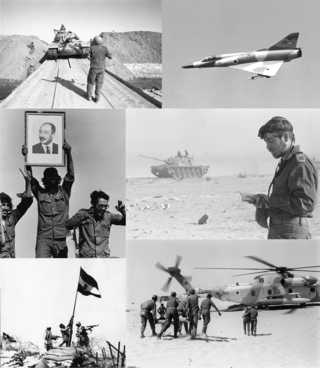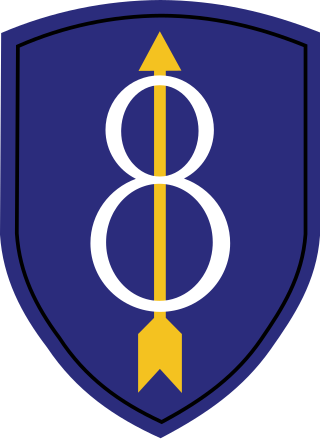Related Research Articles

The Yom Kippur War, also known as the Ramadan War, the October War, the 1973 Arab–Israeli War, or the Fourth Arab–Israeli War, was an armed conflict fought from 6 to 25 October 1973, between Israel and a coalition of Arab states led by Egypt and Syria. The majority of combat between the two sides took place in the Sinai Peninsula and the Golan Heights—both of which had been occupied by Israel in 1967—with some fighting in African Egypt and northern Israel. Egypt's initial objective in the war was to seize a foothold on the eastern bank of the Suez Canal and subsequently leverage these gains to negotiate the return of the rest of the Israeli-occupied Sinai Peninsula.

Operation Badr or Plan Badr was the code name for the Egyptian military operation to cross the Suez Canal and seize the Bar Lev Line of Israeli fortifications on 6 October 1973. Launched in conjunction with a Syrian assault on the Golan Heights, this attack marked the start of the Yom Kippur War.

The 35th "Paratroopers" Brigade is a brigade of the Israel Defence Forces (IDF) consisting of airborne infantry. It forms a major part of the Israeli Ground Forces' Infantry Corps, and has a history of carrying out special operations from the 1950s onwards. Soldiers of the brigade wear maroon berets with the Infantry Corps pin and russet boots. As part of an IDF tradition unique to the brigade, its soldiers wear a tunic and belt over their shirts. The IDF also maintains four reserve paratrooper brigades at all times, whose enlisted personnel consist of reservists that have already completed their compulsory military service in the 35th Brigade.

The 8th Infantry Division, ("Pathfinder") was an infantry division of the United States Army during the 20th century. The division served in World War I, World War II, and Operation Desert Storm. Initially activated in January 1918, the unit did not see combat during World War I and returned to the United States. Some units would serve in the American Expeditionary Force to Siberia. Activated again on 1 July 1940 as part of the build-up of military forces prior to the United States' entry into World War II, the division saw extensive action in the European Theatre of Operations. Following World War II, the division was moved to West Germany, where it remained stationed at the Rose Barracks in Bad Kreuznach until it was inactivated on 17 January 1992.

The 90th Infantry Division was a unit of the United States Army that served in World War I and World War II. Its lineage is carried on by the 90th Sustainment Brigade.

The 9th Infantry Division is an inactive infantry division of the United States Army. It was created as the 9th Division during World War I, but never deployed overseas. In later years it was an important unit of the U.S. Army during World War II and the Vietnam War. It was also activated as a peacetime readiness unit from 1947 to 1962 at Fort Dix, New Jersey, and Fort Carson, Colorado, and from 1972 to 1991 as an active-duty infantry division at Fort Lewis, Washington. The division was deactivated in December 1991.

The Battle of the Chinese Farm took place during October 15 to October 17, 1973 between the Egyptian Army and the Israel Defense Forces (IDF), as part of the Yom Kippur War. It was fought in the Sinai Peninsula, north of the Great Bitter Lake and just east of the Suez Canal, near an Egyptian agricultural research station. The area was known to the Israeli military as the Chinese Farm – a misnomer resulting from the research station's use of Japanese-made equipment, with Japanese writing on the machinery mistaken by Israeli observers for Chinese characters.
The 16th Pomeranian Infantry Division is a military unit of the Polish Army. It was first raised on 16 August 1919 during the Polish uprising, before going on to serve during the subsequent war with the Bolsheviks. At the start of World War II the division fought briefly against the advancing German Army before being destroyed on 19 September 1939 after being surrounded in the Kampinos Forest. The division was raised once more in 1945 following the Soviet takeover of Poland; however, it did not see further action during the war. Afterwards it continued to serve, undergoing a number of changes in name and role. Today, it exists as the 16th Mechanised Division.

The 7th Mechanized Division is a division of the Syrian Arab Army, currently engaged in the Syrian Civil War. It was established before 1973.

Operation Beit-ol-Moqaddas or Operation Toward Beit-ol-Moqaddas was an Iranian operation conducted during the Iran–Iraq War. The operation was a success, as it achieved its standing aim of liberating Khorramshahr and pushed Iraqi troops back to the border. This operation, coupled with Operation Tariq-ol-Qods, and Operation Fath-ol-Mobin, succeeded in evicting Iraqi troops from southern Iran and gave Iran the momentum.
On 25 March 1971, the Pakistani military, supported by paramilitary units, launched the military operation to pacify the insurgent-held areas of East Pakistan, which led to a prolonged conflict with the Bengali Mukti Bahini. Although conventional in nature during March–May 1971, it soon turned into a guerrilla insurgency from June of that year. Indian Army had not directly supported the Bengali resistance but had launched Operation Jackpot to support the insurgency from May 1971.

The 3rd Division was a formation of the Iraqi Army. It was active by 1941, disbanded along with the rest of the Iraqi Army in 2003, but reactivated by 2005.

The Battle of Ismailia took place between the Egyptian Army and the Israeli Defense Forces (IDF) during the last stages of the Yom Kippur War during October 18–22, 1973, south of the city of Ismailia, on the west bank of the Suez Canal in Egypt. The battle itself took place as part of the larger IDF-launched Operation Abiray-Lev, in an attempt to seize Ismailia and thereby sever the logistical and supply lines of most of Egypt's Second Field Army across the Suez Canal.
This is the order of battle for the Six-Day War between Israeli forces and Arab forces which consisted of Syrian, Egyptian, and Jordanian military forces. The war took place on June 5–10, 1967.

The 1st Armoured Division is a division of the Syrian Arab Army. It was established before 1973.
The Second Field Army is a military formation of the Egyptian Army, formed in 1968. Army headquarters is at Ismailia. It is usually commanded by a field commander of lieutenant-general rank of at least 34 years' service, and reports directly to the Army General Headquarters and General Staff.

El-Sa‘ka Forces, is an Egyptian military commando force established in 1955 by Major General Jalal Mahmoud Fahmy Al-Haridi. High fitness is required and training is conducted at the El Sa‘ka Academy built by Major General Ahmed Ragai Ateya. Unit 777 and Unit 999 are divisions of the Sa'ka forces.
This is the order of battle of the German, Greek and British Commonwealth units on 5 April 1941, prior to the German invasion of Greece and Yugoslavia. The German invasion and conquest of mainland Greece is known as the "Battle of Greece".

The Third Field Army is a field army of the Egyptian Army, with its headquarters in Suez. It is now part of the Unified Command of the area east of the canal (Egypt).

Operation Abirey-Halev or Operation Abirey-Lev also known as Operation Stouthearted Men and Operation Valiant, code-named Operation Gazelle, was an Israeli operation that took place in the center of the Suez Canal on 15–23 October 1973 during the Yom Kippur War.
References
- Dupuy, Trevor N. (2002). Elusive Victory: The Arab-Israeli Wars, 1947-1974 . Military Book Club. ISBN 0-9654428-0-2.
- Dunstan, Simon (2007). The Yom Kippur War: The Arab-israeli War of 1973 (Illustrated ed.). Osprey Publishing. pp. 35, 38. ISBN 978-1-84603-288-2.
- Hammad, Gamal (2002). Military Battles on the Egyptian Front (in Arabic) (First ed.). Dār al-Shurūq. p. 903. ISBN 977-09-0866-5.